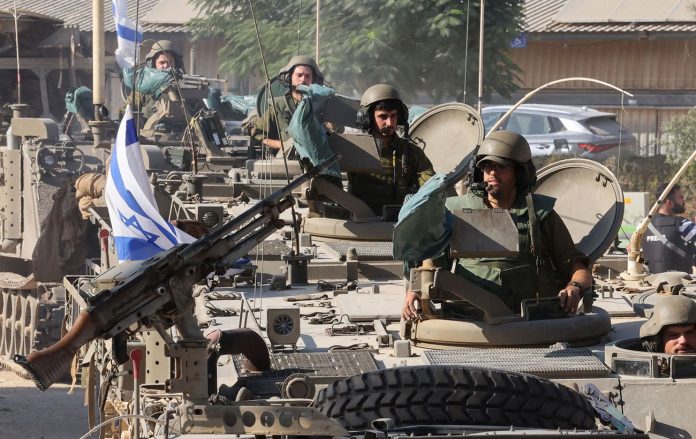Рік після трагедії 7 жовтня, коли напад ХАМАС став найсмертоноснішим днем в історії Ізраїлю, викликає серйозні питання щодо дій ізраїльської армії. Того дня могутня армія країни, здавалося б, готова до будь-яких загроз, була застигнута зненацька. Які ж помилки призвели до такого катастрофічного результату?
ВВС почула розповіді сімей про те, що сталося на одній з військових баз, які охороняють кордон із Газою.
Базу Нахаль-Оз бойовики ХАМАС захопили вранці 7 жовтня, вони вбили, як повідомляли, понад 60 ізраїльських солдатів, а інших взяли в заручники.
Збройні сили Ізраїлю ще не опублікували своє офіційне розслідування того, що сталося на базі того дня, але вони вже поінформували родичів загиблих, і деякі з них поділилися цими подробицями з ВВС.
Намагаючись скласти шматки цього непростого пазлу, ми також поговорили з тими, хто вижив, вивчили повідомлення тих, хто загинув, і прослухали голосові повідомлення, у яких люди повідомляли про атаку. Усе це допомагає скласти картину блискавичного та жорстокого вторгнення.
Що вдалось дізнатися ВВС:
- Підозрілу активність на кордоні до 7 жовтня помічали багато військових на базі, а не лише молоді жінки, завданням яких було стежити за прикордонними камерами.
- Солдати помітили раптове припинення будь-яких дій ХАМАС за кілька днів до атаки.
- Багато ізраїльських військових були неозброєні, в офіційних протоколах також зазначено, що багато хто стояв осторонь, замість того, щоб відбивати атаку.
- Деяке обладнання для спостереження або вийшло з ладу, або його швидко знищив ХАМАС.
Деталі, які ми встановили, порушують запитання, наприклад, про те, чому так мало військових мали зброю на базі, розташованій так близько від кордону, чому практично не було реакції на розвіддані та попередження, чому підкріплення прибуло так пізно і чи була сама база достатньо захищеною.
На наш запит у ЦАХАЛ відповіли, що “ретельно розслідують події 7 жовтня, зокрема те, що сталося у Нахаль-Оз, та обставини, які передували цьому”.
7 жовтня о четвертій ранку Шарон (імʼя змінене) почала свою зміну на базі Нахаль-Оз приблизно за кілометр від стіни на кордоні з Газою.
Шарон служила у жіночому підрозділі бази, завданням якого було вивчати записи камер спостереження, встановлених вздовж огорожі.
Жінки працювали позмінно у кімнаті бази, яка має назву хамаль, цілодобово спостерігаючи за Газою через кілька моніторів.
Хамаль – це кімната без вікон, захищена міцними дверима та противибуховими стінами – усе за суворими протоколами безпеки.
Представники армії Ізраїлю повідомили сім’ям людей, які перебували того дня на базі, що багато військових були неозброєні.
Однак генерал Ізраїль Зів, який у минулому керував оперативним відділом ЦАХАЛу, сказав ВВС, що під час його служби в прикордонних районах ніколи не було неозброєних солдатів.
“Це не має сенсу… Солдат – це той, хто має зброю”, – каже він.
До складу озброєного персоналу в Нахаль-Оз того дня входив підрозділ піхотинців із бригади “Голані” ЦАХАЛу.
BBC встановила, що підвищення підозрілої активності по той бік паркану помічали не лише жінки біля моніторів, але й інші солдати на базі з різних підрозділів.
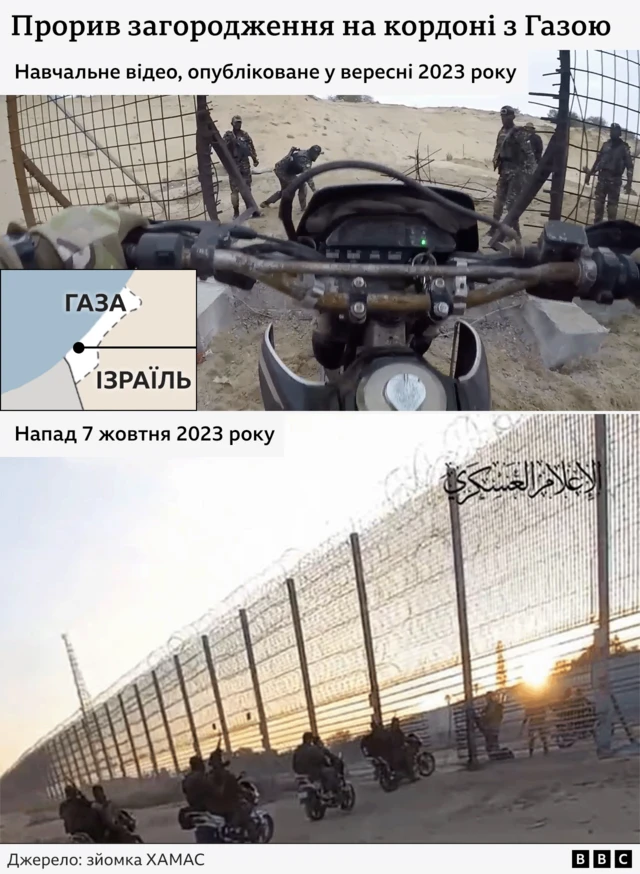
Але за кілька днів до 7 жовтня все затихло.
“Нічого не відбувалося, і нас це лякало, – каже один із піхотинців на базі. – Усі відчували щось дивне”.
Те, що ЦАХАЛ пропустив ці сигнали, пояснюється, на думку генерала Зіва, “великою зарозумілістю”, впевненістю, що “ХАМАС не нападе, не наважиться, і що вони на це не здатні”.
“Шостого числа ми лягли спати, думаючи, що там кіт, а сьомого ми прокинулися та побачили тигра”.
О 05:30 військові бригади “Голані” мали розпочати патрулювання на джипах уздовж ізраїльської сторони огорожі – те, що вони робили до світанку щоранку. Але керівництво наказало їм затримати патрулювання та відійти через загрозу використання протитанкових ракет, розповіли ВВС троє з них.
“Було попередження. Підійматися по трасі біля паркану було заборонено”, – згадує один.
Піхотинець бригади, 21-річний Шимон Малка, сказав, що таке попередження було незвичайним, але не те щоб нечуваним, тому вони не надали йому уваги.
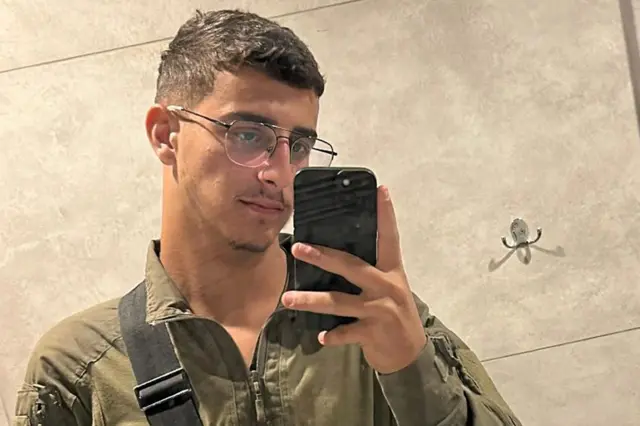
Генерал Зів каже, що це стандартний протокол ЦАХАЛу – затримати людей під час підозрюваних атак, щоб вони не стали ціллю. Але, за словами військового, “ХАМАС це зрозумів і скористався цим”.
Він сказав, що база повинна була мати позиції, з яких піхотинці “Голані” могли б безпечно реагувати.
Але поки вони чекали на відстані від стіни, Шарон помітила рухи серед бойовиків ХАМАС. Утім, вони виглядали звичними – у них теж відбувалися зміни караулу.

О 06:20 ХАМАС почав запускати ракети, але Шарон знову каже, що це не одразу викликало тривогу – база вже зазнавала ракетних атак і була добре захищена від них.
“Зазвичай це п’ять хвилин стрілянини, а потім перерва”, – каже вона.
Але цього разу перерви не було.

Приблизно о 06:30 Шарон побачила, як бойовики ХАМАС почали наближатися.
Її підрозділ зв’язався по радіо з наземними силами, щоб попередити їх.
“Всім станціям, четверо людей біжать до паркану, прийом, – оголосила одна з молодих жінок підрозділу, її голос злегка тремтів. – Я бачу двох озброєних людей, які біжать до паркану, прийом”.
Приблизно у той же час Шимон почув через радіостанцію кодові слова, що означали ракетну атаку. Його командир наказав їм стрибнути з джипа у Namer – тип ізраїльського бронетранспортера – і прямувати до огорожі.
Але він не побачив вторгнення і припустив, що це просто тренування.
Армія оборони Ізраїлю та ізраїльтяни завжди вважали, що стіну на кордоні неможливо здолати. Але бази вздовж неї почали повідомляти про прориви.
Кожна з жінок на зміні у Нахаль-Оз побачила від двох до п’яти проривів на різних ділянках прикордонного паркану, за які вони відповідали, каже Шарон. Вони спостерігали, як бойовики ХАМАС пробираються всередину Ізраїлю.
Генерал Зів каже, що легкість, з якою бойовики здолали паркан, показала, що загорожа не була такою надійною, як вважали.
“Як ви бачили, дві вантажівки просто пробили стіну. Це було нічого. Навіть якби там було 50-60 метрів мінного поля, це затримало б ХАМАС на кілька годин”.
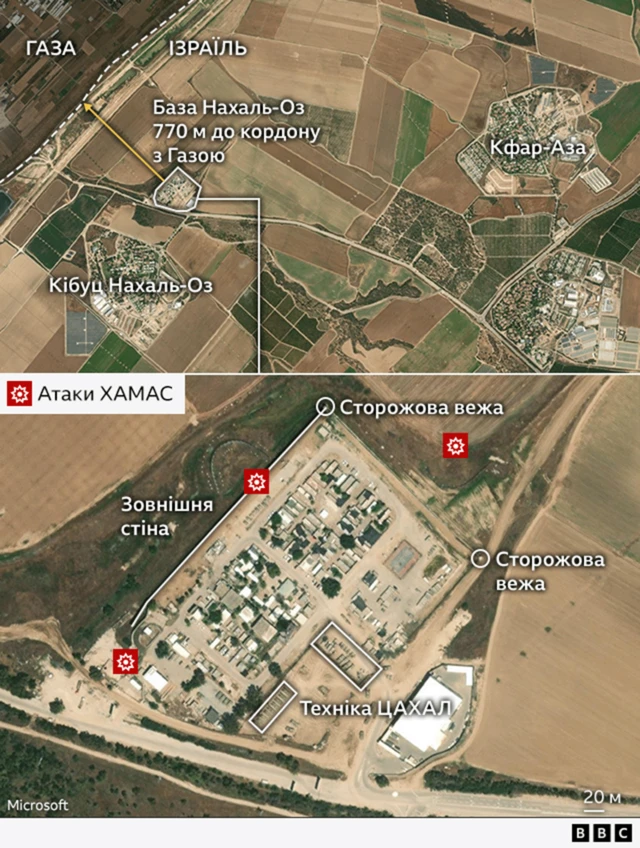
Близько 06:40 спостережний пост у Нахаль-Оз вразила ракета.
Військові на базі почали стріляти у бойовиків, які перетинали паркан, зі снайперської системи, якою вони керували дистанційно з хамаля.
Але незабаром екрани моніторів на базі почали вимикатися – бойовики стріляли у камери спостереження на кордоні.
Лише за 100 метрів від бази розташований спостережний аеростат ЦАХАЛу. Одного з його операторів, Елроя, тим ранком розбудили ракети та сирени, розповів BBC його батько Рафі Бен Шитріт.
Аеростат у Нахаль-Оз надавав кращий огляд углиб Гази, і він мав працювати 24 години на добу.
Але 7 жовтня він, які й інші два аеростати вздовж кордону, вийшли з ладу.
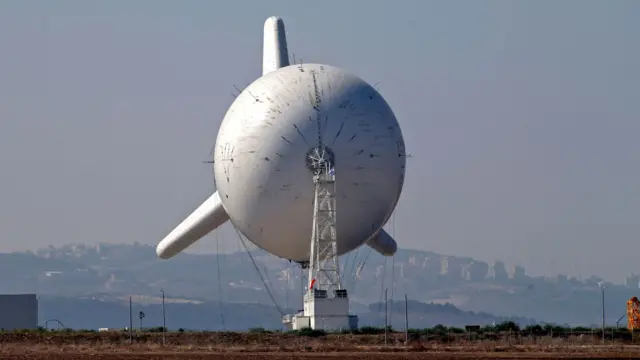
Автор фото,Getty Images
“Аеростат не працював, але ніхто не переймався, їм сказали, що його полагодять у неділю”, – каже Бен Шитріт.
Повернувшись до свого пункту спостереження, Шарон продовжувала шалено передавати інформацію солдатам на землі.
“Я плакала й передавала повідомлення”, – каже вона.
Вона пам’ятає, що командир кричав “тихо”, тому що деякі молоді жінки втрачали увагу посеред цього жаху.
Тим часом Шимон біля огорожі дотримувався вказівок по радіо. Він досі не міг зрозуміти, чому голос дівчини, який він чув, звучав так стривожено.
“Я відчував, що щось відбувається, але нічого не бачив”.
Коли його підрозділ дістався місця, куди їх скерували по радіозвʼязку, вони побачили, як вантажівки ХАМАС проламують огорожу.
“Вони почали по нас стріляти. Можливо, п’ять вантажівок”.
Солдати відстрілювалися та наїхали на деяких мотоциклістів.

Незабаром після 07:00 настав момент, якого всі боялися і ніхто не міг уявити. Бойовики ХАМАС були біля дверей хамаля.
“Вставай, терористи за дверима”, – Шарон згадує, як хтось їй крикнув.
Відділ спостереження отримав наказ залишити свій пост і перейти до офісу всередині бази.
За словами генерала Зіва, вище керівництво армії не приділяло достатньо уваги захисту самих баз, зосередившись натомість на зовнішньому патрулюванні.
“Це було частиною цього хаосу, вони не були готові до того, що ворог зможе зненацька прорвати кордон і зайти на базу. Це був провал”, – каже він.

Приблизно о 07:20 бомбосховище за межами командного пункту атакували.
О 07:38 надійшло повідомлення у WhatsApp від однієї з жінок, які переховувалися там. Серед них були співробітниці відділу спостереження, які у той день не працювали, і чотири жінки-військові, які їх охороняли.
Більше повідомлень від цієї жінки не було.
Армія оборони Ізраїлю повідомила родинам, що ці жінки-військові були єдиними озброєними людьми в укритті. Вони відстрілювалися від бойовиків ХАМАС, поки вибух гранати не вбив їхнього командира і не поранив інших усередині.
На цей момент близько 10 військових змогли перебігти з укриття та зачинитися у житлових казармах. Всіх інших у бомбосховищі вбили або захопили в заручники бойовики.
Шимон і його командир повернулися на базу, але вони все ще не усвідомлювали масштабів того, що відбувається.
Пізніше Армія оборони Ізраїлю поінформувала родину одного із загиблих у Нахаль-Оз, що базу спочатку атакували безпілотники, а потім штурмували 70 бойовиків із чотирьох напрямків, і що пізніше до них приєдналися ще десятки.
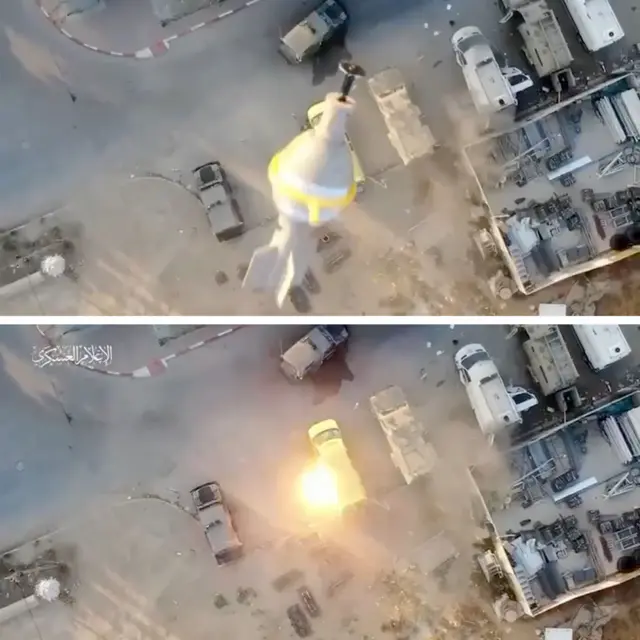
Автор фото,Telegram
Стіну вздовж кордону з Сектором Газа перетнули тисячі людей.
Повертаючись на базу, Шимон почав усвідомлювати масштаб нападу.
“Коли ми прийшли на базу, все горіло”, – каже він.
Водночас, за словами Шарон, всередині командного пункту близько 20 військових намагалися заспокоїти один одного.
Водночас вони продовжували просити підкріплення.
“Здається, хтось сказав щось типу “підкріплення не буде, ніхто не може прийти”, і я пам’ятаю, що мій офіцер сказав: “Нам не потрібно підкріплення, нас треба рятувати”.

Близько 08:00 прилетів ізраїльський безпілотник, відомий як Zik, але йому було важко розрізнити ізраїльських солдатів і ХАМАС, і тому він надто повільно атакував намічені цілі.
Приблизно тоді ж почався штурм командного пункту з інтенсивною стріляниною. Військові, які мали зброю, билися біля дверей будівлі, щоб не дати бойовикам проникнути всередину. Бій тривав близько чотирьох годин.
Шимон каже, що бойовики значно переважали ізраїльських солдатів на базі, а ознак того, що буде підкріплення, не було.
Пізніше ЦАХАЛ повідомить родичам, що того дня на кожних 25 військових, які входили до бази Нахаль-Оз, було 150 бойовиків.
“Тактика ХАМАС того ранку була переважити кількістю”, – каже генерал Зів.
“Вони зробили понад 70 вторгнень… понад 3000 терористів… Вони знали, що не мають відповідної якості бійців, тому зробили ставку на кількість”.
На відео, яке, як повідомляють ізраїльські ЗМІ, зробили приблизно в цей час, видно молодих офіцерок спостереження в Нахаль-Оз, яких захопили озброєні бойовики.
“Ви, собаки, ми вас розчавимо”, – чути, як каже один з чоловіків жінкам, які стоять із зв’язаними руками обличчям до стіни.
Дев’ятнадцятирічна Наама Леві, яка лише напередодні почала працювати на базі, каже на відео, що у неї є “друзі в Палестині”, її обличчя вкрите кров’ю.
На кадрах видно, як жінок затягують у автомобіль і вивозять.
Це жахливі кадри для матері Наами. “Рани, кров, те, що вона говорила, те, що їм казали терористи, це жах”, – каже Аєлет Леві.
За словами генерала Зіва, співробітниці відділу спостереження у Нахаль-Оз “трималися дивовижно – помилкою була система, командири, а не вони”.

Через більш ніж три години після початку атаки, о 09:45, гелікоптер ЦАХАЛу почав вогонь по бойовиках ХАМАС, повідомили офіцери родичам загиблих військових. Він вистрілив у базу 12 разів.
Шимон і шестеро інших піхотинців, разом з їхнім командиром, виїхали з бази і повернулися строєм пішки. Він каже, їх обстрілювали “з усіх боків”.
Через звук автоматичної стрілянини було чути серію поодиноких пострілів, які робив снайпер ХАМАС, якого вони не бачили.
“Щоразу, коли він стріляв, хтось із моїх друзів отримував кулю в голову”, – каже Шимон.
Його самого теж ледь не вбила куля снайпера.
“Я чув як куля просвистіла повз мою голову… Я чув, як кулі вдаряться об бетон навколо мене, відчував їхнє тепло”.
У цей момент він каже, що його радіо більше не працювало.
Генерал Зів описує цей день як “ідеальний шторм”.
“Підкріплення не було так довго, тому що ніхто точно не знав, що відбувається і куди його відправляти”, – каже він.
Шимон утік з місця події і пізніше приєднався до солдатів іншого підрозділу, які пішли захищати кібуц.

Тим часом у командному пункті дещо сталося. Приблизно об 11:00 відключилася електрика, і всі замки на дверях, які працювали на електриці, були розблоковані.
Бойовики ХАМАС почали стріляти та кидати гранати всередину кімнати.
У звіті ЦАХАЛу для сімей сказано, що “терористи кинули легкозаймисту речовину в хамаль і підпалили його”.
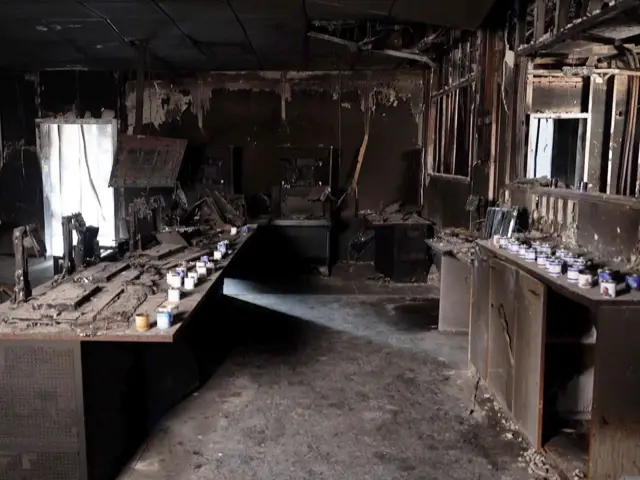
Автор фото,Channel 12
“Дим був дуже густим. Всі почали кашляти і задихатися. Люди почали падати і непритомніти”, – згадує Шарон.
Одна зі співрозмовниць BBC розповіла, що представники ЦАХАЛу сказали їй, що під час нападу ХАМАС використовував “токсичну речовину”, проте інші свідки не згадували цю деталь.

Приблизно о 12:30 семеро людей у командному пункті, разом із Шарон, змогли намацати дорогу до вікна туалету та вилізти назовні.
Вони чекали, що за ними вийдуть й інші, але більше нікого не було. Шарон була єдиною з підрозділу спостереження, хто працював у ту зміну, кому вдалося вижити. Ще одна молода жінка із підрозділу, яка того ранку була на базі, але не працювала, також врятувалася.
До кінця 7 жовтня військові відновили контроль над базою, але багато хто з дислокованих там не пережили цей день. Сімох працівниць підрозділу спостереження захопили в заручники і перевезли у Газу. Одну вбили, одній вдалося врятуватися, п’ятеро досі залишаються в руках бойовиків.
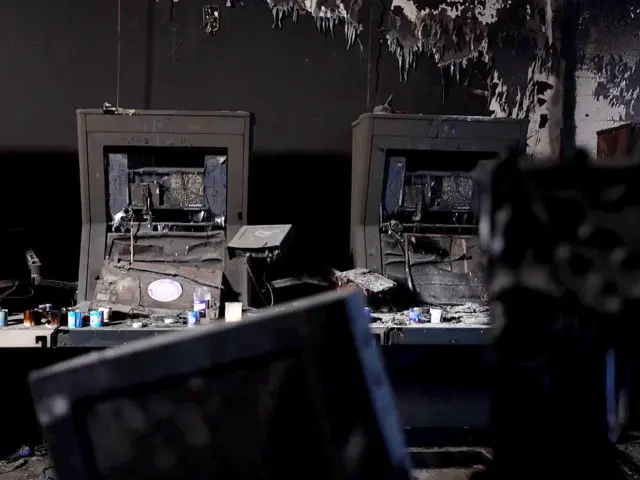
Автор фото,Channel 12
Того дня у всьому Ізраїлі загинули близько 1200 людей, серед них понад 300 військових, ще 251 потрапили у заручники. З того часу понад 41 000 палестинців, за даними міністерства охорони здоров’я ХАМАС, загинули в результаті бойових дій Ізраїлю в Газі.
Серед загиблих в Нахаль-Оз був оператор аеростату Елрой і четверо його товаришів, які витримали довгий бій із бойовиками ХАМАС, каже його батько, посилаючись на інформацію, надану йому ЦАХАЛ.
За його словами, їм вдалося вбити близько 10 бойовиків, але їх було всього п’ятеро проти значно більшої кількості нападників. Їх всіх знайшли мертвими у мобільному сховищі о 14:30.
Командний пункт, розроблений як безпечне місце для підрозділів бази, вщент зруйнували. На фотографіях і відео видно, що він повністю вигорів, а екрани, за якими спостерігали жінки підрозділу, почорніли. Там серед попелу знайшли уламки кісток.
Ті, хто вижив, і сім’ї загиблих досі не мають відповідей на запитання, чому все пішло не так.

